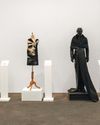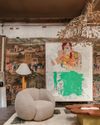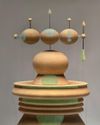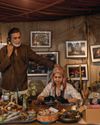
Edited excerpts of AD’s interview with Mrs. Kiran Nadar, chairperson and founder, Kiran Nadar Museum of Art, and Sir David Adjaye, architect for the KNMA building.
(To David Adjaye) What was your first instinctive response to the idea of building in India?
Adjaye: For me, India is very important in architectural history. As a young architect, one tends to begin studying the modern period and goes backwards from there. And as you go backwards in time, you realize how deep the history goes and how impactful the histories of civilizations that have been in India and this region are. As a young architect, I came to India to visit the works of Le Corbusier, [Louis] Kahn, Charles Correa, [B.V.] Doshi—all these incredible modernists. And then I visited Rajasthan and started to go to all the ancient shrines there; I went to Ellora and all its magnificent caves—my mind was blown! You realize how incredibly sophisticated these histor ies and civilizations are. And in my work, I’m very interested in narratives of civilization and places.
So when the competition came up [to build a museum in India], I was naturally thrilled. I also feel connected to India personally. Charles [Correa] was a dear friend. I remember going to his home, with Monika’s exquisite loom right in the hallway, and having supper and talking about architecture. I have very fond memories of visiting Doshi in his studio, Sangath in Ahmedabad, with his Buddha sculpture right there and just sharing incredibly poignant words. My friends in India have been very supportive of me. I may not be an Indian architect. I don’t have it in my DNA so to speak. But I have an insight, and I have an empathy, a deep empathy.
この記事は AD Architectural Digest India の July - August 2023 版に掲載されています。
7 日間の Magzter GOLD 無料トライアルを開始して、何千もの厳選されたプレミアム ストーリー、9,000 以上の雑誌や新聞にアクセスしてください。
すでに購読者です ? サインイン
この記事は AD Architectural Digest India の July - August 2023 版に掲載されています。
7 日間の Magzter GOLD 無料トライアルを開始して、何千もの厳選されたプレミアム ストーリー、9,000 以上の雑誌や新聞にアクセスしてください。
すでに購読者です? サインイン

AS NEW DELHI'S GALLERY ESPACE MARKS ITS 35TH ANNIVERSARY, AD LOOKS AT GALLERIST RENU MODI'S JOURNEY IN ART.
The New Delhi-based Gallery Espace, founded by Renu Modi in 1989, recently marked its 35th anniversary with two special exhibitions.

ROCHELLE PINTO, EDITOR OF VOGUE INDIA, WRITES ABOUT FORCES OF FASHION, WHICH PUT 39 UNIQUE WORKS UNDER ONE ROOF, PIECING TOGETHER A SHORT HISTORY OF FASHION IN INDIA.
If you want to step into the mind of Cristóbal Balenciaga, the game-changing Spanish couturier who died over 50 years ago, all you have to do is beg, bribe or charm your way into 10 Avenue George V in Paris.

AS INVISIBLE COLLECTION COMES TO INDIA, FOUNDERS ISABELLE DUBERNMALLEVAYS AND LILY FROEHLICHER SHARE THEIR SERENDIPITOUS JOURNEY TO THE COUNTRY.
Isabelle Dubern-Mallevays and Lily Froehlicher first found India at their doorstep when Sonam Kapoor Ahuja borrowed a few pieces from their collection for an AD India cover story in 2021.

ANONYMOUS ARTIST PRINCESS PEA SHOWCASES A COLLECTION OF NINE NEW PRINTS AT THE SOHO HOUSE LOUNGE AT ART MUMBAI.
In Princess Pea's new collection of works, poetry, craft and the divine femininity coalesce with grace.

ARTISTS RITU AND SURYA SINGH'S WONDERLAND OF A HOMESTUDIO IN THE PINK CITY URGES YOU TO LOOK AT THE BEAUTY AND NARRATIVE OF WASTE.
Husband-wife artist duo Ritu and Surya Singh, better known as Wolf, live at \"The Farm\", a unique 20-acre madhouse of wonders in the heart of Jaipur.

KENGO KUMA TALKS TO AD ABOUT HIS DESIGN ADDITIONS AS THE CENTRO DE ARTE MODERNA GULBENKIAN IN LISBON OPENS ITS DOORS AGAIN.
Everyone who has lived in Lisbon likely has a fond memory of the Gulbenkian complex.

FROM HIS REVERENCE FOR GANDHI TO HIS LOVE OF DANCE, A BOOK BY DAG OFFERS NEW WAYS TO KNOW MF HUSAIN.
If there was ever an Indian artist who earned immense fame and yet remained unknowable, it is MF Husain.

WHAT WOULD BAWA DO? WONDERS APARNA RAO, COFOUNDER OF PHANTOM HANDS, AS SHE PRODUCES REISSUES OF GEOFFREY BAWA'S HIGHLY CONTEXTUAL FURNITURE.
In mid-December last year, in the freshly restored Kannangara House designed by Geoffrey Bawa in 1959, an exhibition based on the late Sri Lankan master's furniture designs opened.

BANGLADESHI ARTIST AYESHA SULTANA'S RECENT DUBAI EXHIBITION EXPLORED THE DUAL NATURE OF STRENGTH AND FRAGILITY.
Born in Bangladesh in 1984, the US-based Ayesha Sultana explores notions of form, space and materiality.

WE CATCH UP WITH TARIK CURRIMBHOY AT HIS STUDIO IN NEW YORK, AFTER HIS FIRST SOLO SHOW IN INDIA.
Tarik Currimbhoy's sculptures have a pure, meditative quality. A viewer can stand mesmerized for hours watching the elegant, geometric shapes move back and forth.